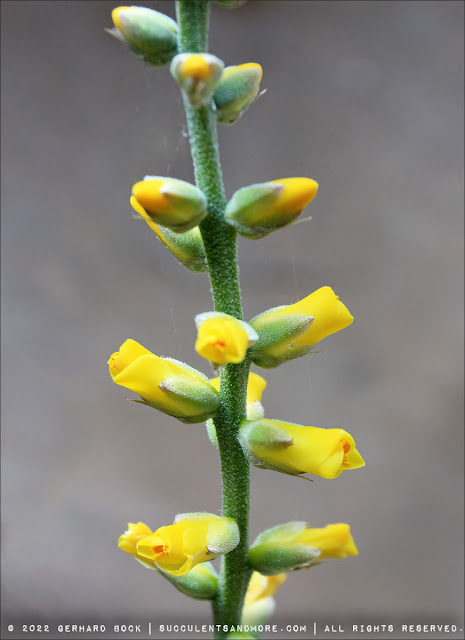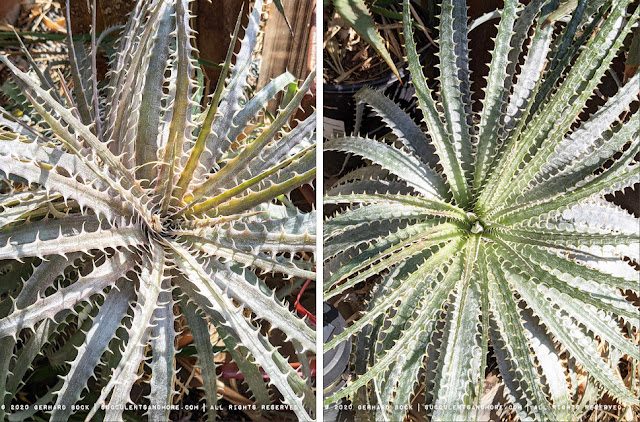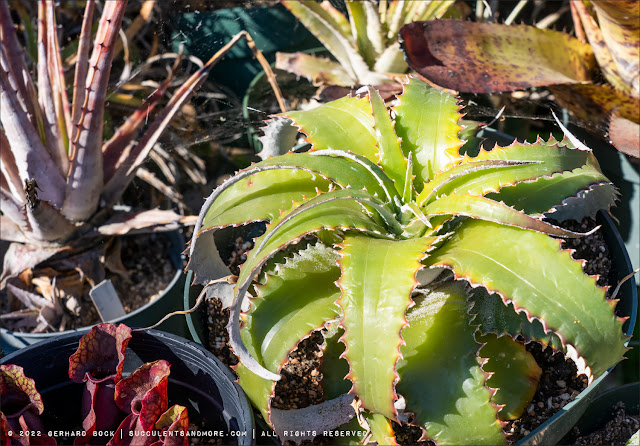Hechtia vs. Dyckia
My previous post on Hechtia lanata raised a common question: how do hechtias differ from dyckias? Both are terrestrial bromeliads (like pineapples), both form rosettes of remarkable beauty, often in large clusters, and both are fiercely armed with barbed teeth along the leaf margins. Visually, they’re difficult to distinguish, as the following example demonstrates:
Some more juxtapositions of hechtias and dyckias to highlight their similarities in terms of general appearance:
↷ Hechtia ‘Wildfire’ vs. Dyckia ‘Arizona’ × ‘Brittlestar’ F2
 |
| Hechtia ‘Wildfire’ (H. texensis × stenopetala) |
 |
| Dyckia ‘Arizona’ × ‘Brittlestar’ F2 |
↷ Hechtia ‘Aztec Sun’ vs. Dyckia ‘Tibor’
 |
| Hechtia ‘Aztec Sun’ |
 |
| Dyckia ‘Tibor’ |
↷ Hechtia fosteriana vs. Dyckia pulquinensis
 |
| Hechtia fosteriana |
 |
| Dyckia pulquinensis |
↷ Hechtia lanata vs. Dyckia platyphylla
 |
| Dyckia platyphylla (photo from dyckiabrazil.blogspot.com) |
↷ Hechtia huamelulaensis vs. Dyckia brevifolia
↷ Hechtia argentea vs. Dyckia ‘Silver Superstar’
 |
| Hechtia argentea (silver) |
 |
| Hechtia argentea × lanata hybrid by Jeff Chemnick |
 |
| Hechtia argentea (red form) |
 |
| Hechtia argentea (silver form) |
↷ And a few more dyckias:
Hechtias and dyckias share a common ancestor, which arose in the Guiana Shield in northeastern South America about 100 million years ago. However, as molecular studies have demonstrated, they aren’t as closely related as once thought. Hechtias (in the subfamily Hechtioideae) and dyckias (in the subfamily Pitcairnioideae) split from their common ancestor at different times—hechtias earlier than dyckias. Hechtias ended up moving north, with their heaviest concentration in what is now Mexico, while dyckias moved south, with their heaviest concentration in what is now Brazil.
These maps show today’s distribution of hechtias and dyckias:
 |
| Distribution of the genus Hechtia |
 |
| Distribution of the genus Dyckia |
While both hechtias and dyckias are similar in terms of appearance, they vary in important characteristics: size, hardiness, and above all flowers.
Size
⮞ Hechtias are larger than dyckias
The hechtias and dyckias you’re likely to encounter in succulent shows and private collections may appear similar in size, with rosettes usually under a foot in diameter, but in the wild, the size difference is much more pronounced.
The Bromeliad Society of Houston says that Hechtia melanocarpa can reach five feet across and produce a flower stalk 8 feet tall. Hechtia myriantha, according to anecdotal reports, can grow to the size of a VW Beetle. Even the hechtias you’re likely to encounter in gardens are larger than your average dyckia.
In comparison, the largest dyckia, Dyckia maritima can reach 4-5 ft. in diameter and height per rosette (see this photo I took at the Huntington). Typically, though, dyckia rosettes are 6-8 inches across.
While many of the photos above show hechtias and dyckias as solitary specimens, both genera tend to offsets heavily, eventually forming extensive colonies. In cultivation, this is rarely desirable, so regular maintenance (i.e. removal of pups) is necessary.
Cold hardiness
⮞ Hechtias are less hardy than dyckias
Neither genus is particularly cold hardy. However, dyckias have an edge over hechtias though they come from Brazil, which you might think is more tropical than Mexico. While hechtias are hardy to the mid to upper 20s (Hechtia texensis is rated at 15°F), several dyckia species like D. platyphylla can take temperatures as low as 15°F. Other hardy dyckias include D. brevifolia and the popular hybrid ‘Naked Lady’.
In all fairness, I should mention that a lot more hardiness data is available on dyckias since they’re much more widely grown. Hechtias are still uncommon in cultivation so there is far less real-world information on how much cold they can actually tolerate. It’s possible that there are other species like H. texensis that can take temperatures in the teens.
Sun exposure/watering
⮞ Hechtias can tolerate more sun and need less water than dyckias
Generally speaking, hechtias come from a harsher environment than dyckias: higher temperatures and less rainfall. As result, they can tolerate exposure even to the hottest spots in the garden—in their natural habitats, they often grow side by side with cacti and agaves—and make do with less water than dyckias. Dyckias are happiest with protection from the hot afternoon sun and regular watering.
⮞ Hechtias have white flowers, dyckias yellow, orange or red flowers
Flowers are the easiest way to tell hechtias and dyckias apart. Hechtia flowers are almost always white (H. rosea has reddish flowers) and inconspicuous, while dyckias have brilliant yellow, orange or red flowers.
Here are two examples of typical hechtia flowers:
 |
| Hechtia glomerata |
 |
| Hechtia argentea |
Hechtia lanata has showier inflorescences with a fluffy appearance reminiscent of a squirrel tail:
 |
| Hechtia lanata (left), Hechtia argentea (right) |
 |
| Hechtia lanata |
 |
| Hechtia lanata |
In addition, virtually all hechtia species are dioecious, i.e. each plant produces only female or male flowers. This means that in order to get seeds, you need to have a female and a male plant in flower at the same time and in reasonably close proximity.
Unlike hechtias, dyckias produce colorful flowers with both male and female parts. This makes pollination, and hence hybridization, much easier. The Bromeliad Cultivar Register of the Bromeliad Society International has 402 (!) entries for dyckias vs. 12 for hechtias.
Here are some examples of dyckia flowers:
 |
| Dyckia brevifolia |
 |
| Dyckia brevifolia |
 |
| Dyckia ‘Silver Superstar’ |
 |
| Dyckia sulphurea (now considered a synonym of D. brevifolia) |
Leaving size and flowers aside, it’s reasonable to say that unless you’re visiting a hechtia collector, most plants you’re likely to encounter in a garden situation are dyckias. So if you’re forced to guess what a given plant is, dyckia is a safe bet.
© Gerhard Bock, 2022. All rights reserved. To receive all new posts by email, please subscribe here.












Thanks for this Gerhard. From your post I assume I have H. argentea as it is a large plant (potted). I have some labelled Dyckias and they are considerably smaller though equally well armed. Due to our short relatively cool summers I doubt I will ever get to see these flower to confirm my guesses. Will just enjoy them as they are.
ReplyDeleteIt sounds like your dyckias have never flowered? I think they will, given time.
DeleteAbove comment is mine.
ReplyDeleteSuch an interesting post! I always wondered about what the difference was. To me, they are both treacherous spiny things I just can't deal with! But they are beautiful ... in photos!
ReplyDeleteThat's how I feel about most opuntias :-)
DeleteYes Opuntias can hurt but they don’t rip my arm up when I accidentally get too close! To each his own!
DeleteThat is true. Bromeliads have barbs that hurt going in and coming out.
DeleteAn excellent post and one I'll bookmark for future reference, Gerhard. I'd be hard-pressed to differentiate the 2 but your guidance will be helpful if I find myself trying to do just that. They're a lot of beauties among your photographs of Hectias. All I have are Dyckias at present.
ReplyDeleteAre your dyckias in pots? They'd look great planted out in your bromeliad bed.
DeleteVery informative. Thank you.
ReplyDeleteToo spiny for me, will admire from a safe distance!
Prickly they are, there's no denying it!
DeleteThanks for this informative overview Gerhard, I really enjoyed it and it will make great reference. I only have one measly Dyckia -they are rarely seen locally. I probably got it at RBG . As for Hechtias, I can't say I've ever seen them offered anywhere-including Socal.
ReplyDeleteAnnie's Annuals typically carries a few dyckias, as does the Ruth Bancroft Garden nursery.
DeleteAs for hechtias, if you ever make it to San Diego County, Jeff Moore/Solana Succulents almost always has a small selection.
Grazie, finalmente chiarezza e precisione nella distinzione delle Dyckia e Hechia grazie. Ho appena comprato una decina di piccole Dyckia...amo le loro spine i loro colori
ReplyDeleteIt’s worth noting Hechtia texensis/scariosa grow in areas of West Texas that have seen record low temperatures approaching 0°F.
ReplyDeleteThat's great to know! A lot of people will be able to grow Hechtia texensis - many hechtias from further south are quite cold-sensitive.
Delete